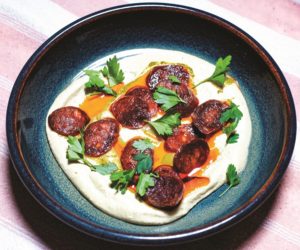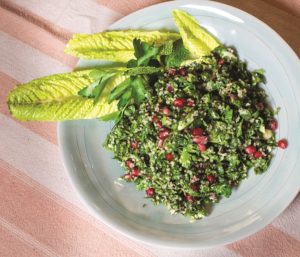I was never a fan of hummus. I had been scarred by memories of too many tubs of the bland, cement-like commercial stuff, consumed on dry carrot nubs after my kid’s soccer practice.
But a trip made in the Before Times changed all that. I joined my husband, Robert, when he went to Lebanon to explore his family heritage. There, hummus was light and lemony. It was an essential mezze — the small plates that started most of our meals there — but also a foundation for creative variation. I loved how cooks there presented it as a swirling, silky canvas for toppings that ranged from a dusting of za’atar (a thyme and sumac spice blend), to roasted pine nuts or tomatoes, spiced ground beef, or, my favorite addition, seared chorizo.

Back home, I began my hummus rehab, turning to books by chefs who’ve brought the Middle East’s diverse culinary culture into view in recent years — Anissa Helou (a fabled writer and teacher who goes beyond her Lebanese and Syrian roots in Feast: Food of the Islamic World), Michael Solomonov (the book I consulted is Zahav, which is also the name of his Philadelphia restaurant), and Yotam Ottolenghi (he takes eight pages to describe hummus in Jerusalem: A Cookbook).
My recipe takes a bit from each of theirs. And, yes, it starts with soaking dried chickpeas, so although this hummus is very simple to make, you will need to start it the day before you dig in.
Soaking and cooking the beans with baking soda softens their skins. And incorporating ice water makes for a super-creamy emulsion of the tender beans and the sesame tahini paste. The other key is to search out great tahini — look for lighter colored versions without a ton of oil on top, as that’s a sign the sesame is old or roasted. Solomonov recommends a brand called Soom, which can be ordered online. But Robert makes a pilgrimage to the Cedar Market in his old neighborhood in Norwood. for Beirut tahini whenever he goes to visit his stepfather there.
Before our trip to Lebanon, I was not unfamiliar with the deliciousness of the Middle Eastern kitchen. My husband’s Syrian grandmother wisely divided up her culinary repertoire between her four daughters, creating a bond that kept them all close. One sister was schooled in pastries, another mastered kibbe, sister number three took on the stuffed squash. My mother-in-law, June, was the keeper of the tabbouleh. Her summer garden — loaded with tomatoes, scallions, mint, and parsley — reflected her commitment.
June’s tabbouleh wasn’t a soggy bulgur wheat salad, as so many American adaptations are, but was instead a vibrant parsley salad with a hint of wheat. She was particular about each ingredient: the parsley must be chopped by hand (a food processor bruises the herbs) and ripe tomatoes had to be seeded or her salad was too wet. Fine bulgur was soaked and drained and shaken in her dented old colander until it was bone dry. Her meticulous final seasoning with fresh lemon juice and salt was a sacred moment that brought all the elements into alignment.
I am forever grateful to her for all the summer afternoons we spent on her deck in Wellfleet dicing tomatoes. Which reminds me to say that I know tabbouleh may seem an odd winter choice. And I would never make it with winter tomatoes — June would spin in her grave. In winter, I take a cue from Beiruti cooks and use pomegranates instead. They add a pop of sweetness, texture, and their jewel-like color to a parsley-rich winter salad.
Here’s how I seed a pomegranate: halve it crosswise, then hold the cut side over a bowl and whack the tough skin with a wooden spoon to release the seeds. Discard any white pith with the skin.

Homemade Hummus
Makes about 2½ cups
¾ cup dried chickpeas
1 tsp. baking soda
1 to 2 cloves garlic
1 tsp. kosher salt
2 strips lemon zest
Juice of one lemon
½ cup tahini, at room temperature
1/3 cup ice water
Extra-virgin olive oil
Put the chickpeas in a bowl with a half teaspoon of baking soda plus water to cover the beans by about 2 inches. Set aside overnight.
Drain the chickpeas and transfer them to a medium pot. Add the remaining half teaspoon baking soda and a half teaspoon of the salt. Add the 2 strips of lemon zest. Cover chickpeas with 2 to 3 inches of water and cook until they are very soft with no resistance, about 40 minutes, depending on the age of the legumes. Drain (leave in the zest) and rinse with cold water.
While the chickpeas cook, mince the garlic with the remaining half teaspoon salt and smash it with a broad chef’s knife, pressing it into a smooth paste. (Alternatively, smush the garlic and salt with a mortar and pestle.) Combine the smashed garlic with the lemon juice and set aside until the chickpeas are tender.
Put the cooked chickpeas in a food processor along with the lemon-garlic mixture, and pulse into a coarse puree. Pulse in the tahini. With the machine running, slowly add the ice water and continue to process until silky and smooth, up to 2 minutes. Season with additional salt to taste. Refrigerate until ready to serve — the hummus will thicken in the fridge.
To serve, spoon hummus on a platter and use the back of the spoon to swoosh it over the plate. Drizzle with olive oil, spices, or parsley.
Serve with warm pita bread and fresh vegetables alongside. Or cook sliced chorizo sausage in olive oil until the edges crisp slightly and the oil turns red. Spoon sausage and oil over the hummus. Cumin, za’atar, paprika, and parsley all make good garnishes.

Winter Tabbouleh With Pomegranate
Makes about 3 cups
3 tablespoons fine bulgur
Leaves from 3 bunches flat-leaf parsley (stems discarded)
1 loosely filled cup mint leaves
2 scallions, white and about 2 inches green, thinly sliced
3 Tbsp. extra-virgin olive oil
1/3 cup pomegranate seeds
Juice of ½ lemon
Pinch allspice and cinnamon
½ tsp. kosher salt, or to taste
Bring a kettle of water to a boil. Put the bulgur wheat in a bowl and pour boiling water over it, to cover. Set aside until the wheat plumps and gets tender, about 5 minutes. Drain and shake in a colander until very dry.
Finely chop the parsley leaves and mint by hand. Using a sharp knife is the key to not bruising the herbs. Combine the parsley and mint in a large bowl with the wheat. Add the olive oil and toss to coat. Add the pomegranate seeds, lemon juice, spices, and salt and stir lightly to combine.
